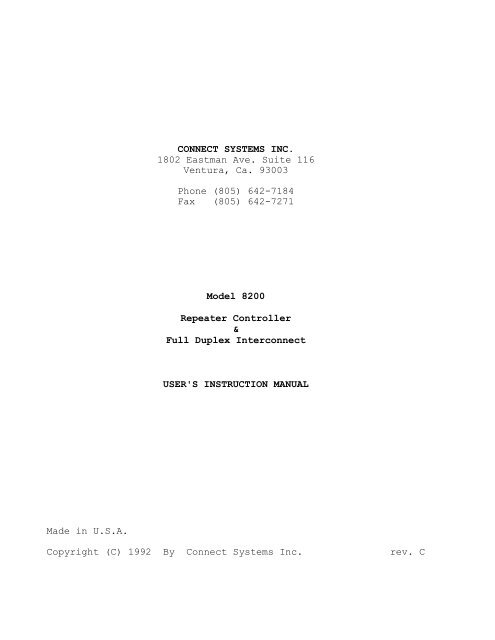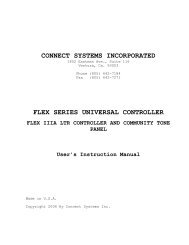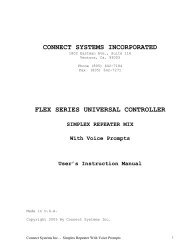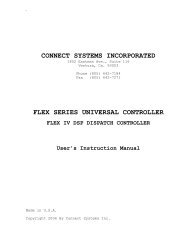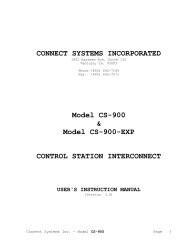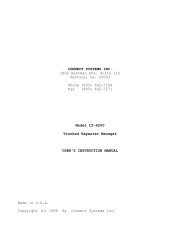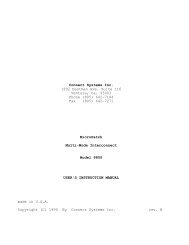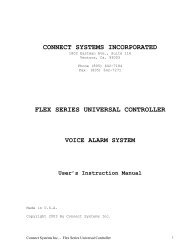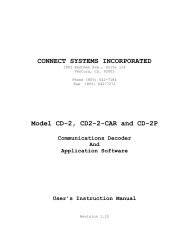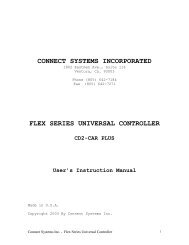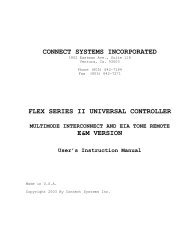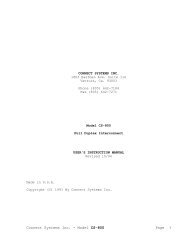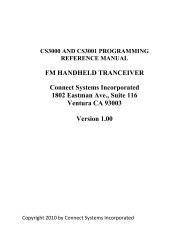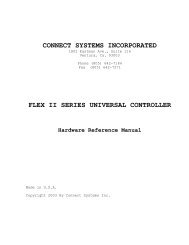CS8200 - Connect Systems
CS8200 - Connect Systems
CS8200 - Connect Systems
You also want an ePaper? Increase the reach of your titles
YUMPU automatically turns print PDFs into web optimized ePapers that Google loves.
Made and designed in the U.S.A.INSTALLATION AND ADJUSTMENTSThe 8200 contains both a noise squelch and COS circuits with COSinput. This gives the 8200 a great deal of interface flexibility.The audio takeoff point can be anywhere from the discriminator(pre-emphasized audio) to the volume control (de-emphasized orflat audio). If connection is made to the discriminator, onlythree connections are required to most radios. When connectingpast the discriminator, a fourth COS connection must be made. Useshielded wires with the shields at both ends connected to chassisground. (The rear panel barrier strip terminals labelled "GND"are chassis ground). We recommend using spade type crimp-onconnectors for ease and reliability. <strong>Connect</strong> the center wires asfollows:AUDIO IN: The audio input terminal may be connected directly tothe discriminator output, or to the high end of thevolume control.If connecting to the discriminator...1. A COS connection to the receiver is notrequired.2. The de-emphasis strap JP-5 must not be cut.3. The COS polarity strap JP-1 must not bestrapped.4. The noise control P2 must be adjusted toilluminate the front panel noise LED. See "P2NOISE" below for further explanation.If connecting to the volume control high side...1. A COS connection must be made.2. Cut JP-5 to eliminate built-in de-emphasis.3. JP-1 must be strapped for the appropriate COSpolarity.4. The noise control must be set at minimum.(fully CCW).5. The COS threshold control P7 must be set tomatch the level of the COS takeoff point.<strong>Connect</strong> <strong>Systems</strong> Inc. - Model 8200 Page 4
JP-3 Audio output range strap. Strap in = low level (0-1 V).Strap removed = high level (0-5 V). Strap factoryinstalled.JP-4 Factory installed. Should only be removed if CTCSS optionTSU-32P is installed. Note: See page 35 for TSU-32Pinstallation information.JP-5 Factory installed. Removal eliminates the built-in deemphasisnetwork. Cut only if receiveraudio is taken past de-emphasis.JP-6 Selects whether the Aux. Relay output is normally open (NO)or, normally closed (NC). JP-6 is factory strapped for NO.For NC operation, connect the center pad to the NC pad. Itmay be necessary to remove the rear panel to make thismodification.JP-7 JP-7 is used to enable / disable the line in use detectionsensor. The 8200 is delivered with the line in usedetection sensor disabled (JP-7 not strapped). To enablethe line in use detection sensor remove the plastic push-onclip from one of the JP-7 legs and re-install on both ofJP-7's legs.Note: User programming line 1.2. must be programmed 0(disabled) if JP-7 is not strapped. Otherwise the 8200 willalways think the line is in use and will give you the lineis busy alert when you attempt to make a call.WHAT IS A HYBRID?Every telephone has a hybrid (sometimes called a network). Thepurpose of the hybrid is to attenuate the level at which you hearyourself speaking, without affecting your level at the other endor vice-versa.Various noises in mobile radio communications systems demand thatthe hybrid in a full duplex terminal should have significantlybetter performance than a telephone hybrid. Otherwise the duplexmobile would hear excessive return trip audio (echo) and noise.To achieve optimum trans-hybrid isolation, resistive andcapactive nulling (balance) adjustments are required.<strong>Connect</strong> <strong>Systems</strong> Inc. - Model 8200 Page 9
until 0 1 0 1 .060optimum 0 1 1 0 .072null 0 1 1 1 .082is 1 0 0 0 .100achieved 1 0 0 1 .110| 1 0 1 0 .122| 1 0 1 1 .132| 1 1 0 0 .150| 1 1 0 1 .160V 1 1 1 0 .172Maximum Setting 1 1 1 1.182 uF (max)0 = OFF1 = OffFIGURE 1Table of hybrid compensation settings.*****************************************************************PHONE LINE CONNECTIONThe 8200 is equipped with a standard RJ-11 modular phone jack andmay be connected to standard ring-tip loopstart CO lines. Thefollowing information must be given to the telephone companyprior to connecting:RINGER EQUIVALANCE: 0.6BIn U.S.A.FCC REG. NUMBERIn CanadaDOC REG. NUMBER: 2CAUSA - 73145 - OT - T: 1755 4686 AThis equipment may not be connected to coin or party lines. Besure to notify the phone company when discontinuing use. The linein use feature may not be enabled on lines requiring FCC part 68or DOC registered apparatus. (See JP-7 page 8 and userprogramming line number 1.2. page 14). Please refer to AppendixA at the rear of this manual for additional information.PROGRAMMING THE 8200The 8200 has four easy-access programming areas: 1. OperatingParameters, 2. CW ID, 3. Auto-Dial Phone Numbers, and 4. ANI<strong>Connect</strong> <strong>Systems</strong> Inc. - Model 8200 Page 11
Access Codes. To enter one of the programming areas, turn thepower off, press and hold the corresponding programming areabutton (No. 1 for Operating Parameters, No. 2 for CW ID, No. 3for Speed-Dial Numbers or No. 4 for ANI Access Codes) andsimultaneously turn on the power. The display will show 0.x.,where x is the number of the programming button that is beingpressed. Release the button, and programming may begin.Each programming area has the following features in common:1) Programming line numbers are displayed with the dotsilluminated on the displays. e.g. 0.1., 4.5. etc.2) Data values are displayed without the dots illuminated.e.g. 00, 30, etc.3) Data is entered at a line number by pressing the desireddigits followed by the 'P' key. Consider the 'P' key asthe enter key.4) The GOTO Any Address line is displayed as A.A. This lineis used to branch to any line number in the currentprogramming area. For example, the current line is A.A.and you wish to goto line 30. Enter 3 0 P on the keypadand the display will read 3.0.5) Pressing only P at the A.A. line will advance the lineto 0.1. Pressing only P at any other line will advance tothe next available programming line. NOTE: In CW ID,Auto-Dial Phone Number programming, and ANI Access Codes,the next line will be the next numeric line number. InOperating Parameters programming the next line is notnecessarily the next numeric line (see the 'Programmingthe Operating Mode and Parameters' section).6) To view the stored data at a given line number, brieflypress C on the keypad and then release it. The displaywill then show the data for a few seconds and then redisplaythe current line number. Consider 'C' the 'see'data key.7) At any point during programming, you may return to theA.A. line by holding down the C key until A.A. appears onthe display (approximately three seconds).<strong>Connect</strong> <strong>Systems</strong> Inc. - Model 8200 Page 12
PROGRAMMING THE OPERATING MODE AND PARAMETERS(Programming Area No. 1)To enter the parameter programming mode, press and hold buttonNo. 1 on the internal keypad and then simultaneously turn on thepower switch. At this point, the display will read 0.1. When yourelease the No. 1 button, you will see A.A.A.A. (GOTO Any Address)Press 'P' to start at line 0.1., or enter the line numberyou wish to go to and then press 'P'. All line numbers andtheir associated parameters are listed below starting withREPEATER CONTROLLER PARAMETERS.Viewing or Changing Parameter ValuesA quick tap on 'C' will reveal (for a moment) the currentlyselected parameter of the displayed program line. If theparameter is acceptable, press 'P' to advance to the nextprogram line, or, enter a new parameter and press 'P' toadvance to the next program line.Parameter CheckingIf an out of range parameter is entered (eg. 6 on line0.1.) pressing 'P' will not cause an advance to the nextprogram line. This prevents you from accidentally enteringan unuseable choice.Returning to A.A.Programming is finished when you arrive back at A.A. Ifnecessary, you can return to a previously programmed line byholding down 'C' for several seconds. This will return youto A.A. Now enter the line number you wish to return to andpress 'P'. Line sequential programming will always flowforward from the current line.Line numbers shown in braces e.g. [0.8.] indicates whereprogramming will continue after a selection.When you finish programming, simply turn the power off, andthen back on to return to the operate mode.REPEATER CONTROLLER PARAMETERS[Branch to]0.1. Repeater Controller<strong>Connect</strong> <strong>Systems</strong> Inc. - Model 8200 Page 13
1 = Enable [0.2.]0 = Disable [0.8.]DEFAULT: 0 = Disable1 - Enable use of the Repeater controller.0 - Disables the use of the Repeater controller.0.2. Repeater On/Off Control CodeEnter any three digits: xxxprotocol: #xxx = ON##xxx = OFFDEFAULT: 456Select any three digits as an over the air repeater on/offcontrol code. Press # plus the three digits to turn on therepeater. Press ## plus the three digits to turn off therepeater.0.3. Repeater Mode CW ID Interval0 = DisableSelect 1-99 (.1-9.9 minutes).1 min increments per stepDEFAULT: 30 = 3 minutesChoose the CW ID interval that you prefer for repeater mode.Or, disable repeater mode CW ID by pressing 0. The CW IDinterval is equal to .1 minutes times the number entered0.4. Repeater Hang TimeSelect 5-99 (.5-9.9 seconds)Or, Enter 0 for instant dropout. (No courtesy beep).1 sec increments per stepDEFAULT: 30 = 3.0 secondsSelects the time in seconds that the repeater remains on theair after the input signal drops. The time is equal to .1second times the number entered.0.5. Repeater Activity Timer0 = DisableSelect 1-99 (.1 - 9.9 minutes).1 minute increments per stepDEFAULT: 5 = .5 minutesAny single continuous mobile transmission exceeding therepeater activity timer limit puts the repeater off the air.The activity time in minutes is equal to the number entereddivided by ten. Pressing 0 disables the activity timer.0.6. Courtesy Beep1 = Enable [0.7.]<strong>Connect</strong> <strong>Systems</strong> Inc. - Model 8200 Page 14
0 = Disable [0.8.]DEFAULT: 1 = EnableIf enabled, the courtesy beep sounds each time a mobile isfinished talking. This lets the other mobile know for surethat you have finished and that it's time to respond.0.7. Courtesy Beep CharacterSelect 0-37DEFAULT: 17 = "R"This choice allows selecting any morse code character fromTable 1 (page 21) as the courtesy beep. The default is 17which sends "R" for roger. If a short beep is desired entera 4. For a long beep enter 19.INTERCONNECT OPERATING PARAMETERS0.8. Interconnect Operating Mode1 = Semi-Duplex [0.9.]2 = Full Duplex [1.0.]0 = Disable [A.A.]DEFAULT: 2 = Full Duplex0.9. Semi-Duplex Privacy Mode1 = Enable0 = DisableDEFAULT: 0 = DisableIn privacy mode, the mobile side of the conversation is notre-transmitted. Thus eavesdroppers only hear one half of theconversation. Thus providing a good measure of security.1.0. ANI Remote Programming Codexxxx = User selectable ANI remote programming codeProtocol: ###xxxx (Enters Remote Programming Mode)DEFAULT: 9876Selects the code which is used to enter the remoteprogramming mode. The remote programming mode permits theremote selection or changing of the interconnect accesscode(s). See ANI Access Code Programming page 23 for moredetail.1.1. Disconnect Code0 = # Down1 = # Plus <strong>Connect</strong> CodeDEFAULT: 0 = # Down<strong>Connect</strong> <strong>Systems</strong> Inc. - Model 8200 Page 15
Choose the patch disconnect code. Enter 0 to select # downin most applications. Or enter 1 to select # plus theconnect code digits.1.2. Line in Use Detect NOTE: Do not enable unless1 = Enable JP-7 is strapped. See page 8.0 = DisableDEFAULT: 1 = EnableWhen enabled, mobiles are prevented from cutting in on callsthat are already in progress on the same line.1.3. Five PTT speed-dial1 = Enable0 = DisableDEFAULT: 0 = DisableIf enabled, five presses of the mobile Mic button (at a rateof approximately one push per second) will automaticallydial the phone number stored in speed dialer memory locationNo.1. Five subsequent presses will cause a disconnect.1.4. Dialing Mode1 = Tone0 = PulseDEFAULT: 1 = ToneSelect how the 8200 will dial your phone calls. Note thattone is much faster if you are in a touchtone telephoneexchange.1.5. Access DelaySelect 1-9 (1-9 seconds)1 sec increments per stepDEFAULT: 2 = 2 secsAccess delay is a user selectable delay to compensate forDTMF-PTT delay built into your mobile microphone. Select avalue that allows you to hear all of the CW ID and/ordialtone without clipping.1.6. Manual Dialing1 = Enable [1.7.]0 = Disable [2.2.]DEFAULT: 1 = EnableSelect disable if dialing should only be allowed from thespeed dialer memory.1.7. Toll Restrict Digit Counting1 = Enable<strong>Connect</strong> <strong>Systems</strong> Inc. - Model 8200 Page 16
.5 minute increments per stepDEFAULT: 6 = 3 minutesSelect the maximum call limit time. The time is equal to .5minutes (30 seconds) times the number you enter.2.4. CW ID1 = CW ID at connect and disconnect.0 = CW ID at disconnect only.DEFAULT: 0 = At disconnect only.After accessing, manual dialing and auto-dialing are delayeduntil the CW ID is finished if you enter 1.2.5. Automatic Busy Signal Disconnect1 = Enable0 = DisableDEFAULT: 1 = Enable2.6. Automatic Dialtone Disconnect1 = Enable0 = DisableDEFAULT: 1 = Enable2.7. Aux. Relay0 = <strong>Connect</strong> [2.9.]1 = Monitor [2.9.]2 = Key [2.9.]3 = Remote Function [2.8.]DEFAULT: 0 = <strong>Connect</strong>0. In connect mode, the relay is on whenever the patch is inconnect.1. In monitor mode, the relay can only be functioned whenusing Remote Base mode from a touchphone. Pressing 0turns on the relay. Pressing * turns it back off. Therelay returns to off automatically when Remote baseoperation is completed. This function is normally used toremotely disable CTCSS so the channel can be monitoredprior to initiating dispatch from a phone.2. In key mode, the relay is on whenever the PTT isactivated.3. Remote Function provides a remotely controllable contactclosure/opening which can be used for any purpose.NOTE: Option 8205 (Aux. Relay) is required for the above.2.8. Remote Function Access Codexxx = Any three digits<strong>Connect</strong> <strong>Systems</strong> Inc. - Model 8200 Page 18
Protocol: #xxx relay ON##xxx relay OFFDEFAULT: 789Sets the control code for the Aux. Relay Remote Function.Enter any three digits. To turn on the relay press #xxx. Toturn off the relay press ##xxx. This functions only if youentered 3 on line 2.7. Note: Do not operate the remotefunction while the 8200 is in connect.INCOMING CALLS2.9. Busy Channel Monitor1 = Enable0 = DisableDEFAULT: 0 = DisableDetermines whether the 8200 will ringout or auto-answer ifthe channel is busy (Enter 0). Or only when the channel isclear (Enter 1).3.0. Ringout on Ring Number0 = Disable [3.4.]Select 1-9 (1-9 ring) [3.1.]DEFAULT: 1 = First RingSelects which incoming ring starts the ringout alert. Enter1-9 or enter 0 to disable ringout. Ringout is used forreceiving ordinary phone calls.3.1. Ringout Alert1 = Ring Tone0 = CW IDDEFAULT: 1 = Ring ToneSelect whether the ringout alert will consist of a Ring Toneor CW ID. The Ring Tone is similar to a telephone ring. Youmay also include a DTMF sequence by programming line 3.2.3.2. Ringout DTMF Sequence000000 = None (display reads ' -')x-xxxxxx = DTMF SequenceDEFAULT : - = NoneEnter a 1-6 digit DTMF sequence to be sent during theringout alert interval. For no DTMF sequence enter 000000.3.3. Ringout Once or On Alternate Rings1 = Once0 = Alternate<strong>Connect</strong> <strong>Systems</strong> Inc. - Model 8200 Page 19
DEFAULT: 1 = OnceOnly a single ringout alert is allowed in most businessradio applications.3.4. Auto-Answer Ring Number0 = Disable [A.A.]Select 1-9 (1-9 ring) [3.5.]DEFAULT: 0 = DisableSelects which incoming ring initiates auto-answer. Enter 1-9or enter 0 to disable. If auto-answer is set to a greaternumber of rings than ringout, you can have ordinary ringoutalerts until auto-answer occurs. After auto-answer, remotebase, selective calling or talk back paging can be initiatedfrom any telephone.3.5. Telephone Remote Base0 = Disable [3.6.] NOTE: Enter "0"1 = Automatic on Auto-answer [3.8.] if tone signaling2 = Access Code Required [3.8.] is to be usedwithDEFAULT: 0 = Disableremote base mode.Enter 0 if remote base operation is not desired or ifselective calling or talk-back paging is to be used. Enter 1if remote base operation should automatically occur afterauto answer. Enter 2 if an access code should be requiredfrom the initiating phone after the auto-answer beep. (Sameaccess code used by mobiles)3.6. Selective Calling or Talk-Back Paging1 = Selective Call Mode [3.8.]0 = Talk back Page Mode [3.7.]DEFAULT: 1 = Selective Call ModeIf talk back paging is selected the 8200 will only deliver aone_way voice message to a pager.3.7. Talk Back TimeSelect 1-9 (3-27 seconds)DEFAULT: 8 = 24 secsSets the talk time for talk back paging. Talk time is equalto three seconds times the number entered.NOTE: If CTCSS is used as a talk-back paging tone, resistorR8 must be removed. Simply lift or cut one end.<strong>Connect</strong> <strong>Systems</strong> Inc. - Model 8200 Page 20
TONE SIGNALLING PARAMETERS3.8. Mobile to Mobile Signalling Note: DTMF signalling does not1 = Enable operate if one of the optional0 = Disable tone formats has beenDEFAULT: 0 = Disable installed.When enabled, the 8200 can convert a mobile initiated DTMFsequence into any of the optional tone formats. For example:DTMF to Two Tone signalling. Mobile to mobile signaling isonly functional if option 8202, 8203 or 8204 is installed.See page 29 for details.Branching:DTMF to: [A.A.] if no tone option is installed.CTCSS to: [3.9.] if option 8203 is installed.TWO TONE to: [4.0.] if option 8202 is installed.5/6 TONE to: [4.1.] if option 8204 is installed.3.9. CTCSS Beep Alert (Option 8203 required)Select 3-9 (3-9 beeps)DEFAULT: 6 = 6 BeepsSelect the number of alerting beeps that accompany theselected CTCSS tone for selective calling. See Table 2 forCTCSS selective call codes.4.0. Two Tone Group Call or Diagonal Tone (Option 8202 required)1 = Group Call [A.A.]0 = Diagonal [A.A.]DEFAULT: 1 = Group CallNOTE: See Table 3 for Two Tone selective call codes.4.1. Five Tone Preamble (Option 8204 required)1 = Enable [4.2.]0 = Disable [4.3.]DEFAULT: 0 = DisableSelect the selective call code and all appropriate 5/6 toneparameters from Table 4.4.2. Preamble ToneSelect tone 0-9DEFAULT: 0 = Tone 04.3. First Tone SelectSelect tone 0-9DEFAULT: 0 = Tone 04.4. Second Tone Select<strong>Connect</strong> <strong>Systems</strong> Inc. - Model 8200 Page 21
Select tone 0-9DEFAULT: 0 = Tone 04.5. Repeat SequenceSelect 1-9 (Repeat 1-9 times)DEFAULT: 1 = Once4.6. Duration of TonesSelect 1-99 (1-99 ms)DEFAULT: 33 = 33 ms4.7. Tone Group Select1 = EIA [A.A.]2 = ZVEI1 [A.A.]3 = CCIR/EEA [A.A.]4 = CCIT [A.A.]5 = EURO [A.A.]DEFAULT: 1 = EIA (See Table 4)PROGRAMMING THE CW ID(Programming Area No. 2)To enter the CW ID programming mode, press and hold button No. 2on the internal keypad and then simultaneously turn on the powerswitch. At this point, the display will read 0.2. When yourelease the No. 2 button, you will see A.A.A.A. (GOTO Any Address)Press 'P' to start at character position 0.1., or enter thecharacter position number you wish to go to and then press'P'.Viewing or Changing Character CodesA quick tap on 'C' will reveal (for a moment) the currentlyselected character code for the displayed characterposition. If the character code is acceptable, press 'P' toadvance to the next character position, or, enter a newcharacter code and press 'P' to advance to the nextcharacter position.Character Code Range CheckingIf a number greater than 38 is entered, pressing 'P' willnot cause an advance to the next character position. Thisprevents you from accidentally entering an unuseable choice.<strong>Connect</strong> <strong>Systems</strong> Inc. - Model 8200 Page 22
Returning to A.A.If desired, you can return to a previously programmedcharacter position by holding down 'C' for several seconds.This will return you to A.A. Now enter the characterposition (line number) you wish to return to and press 'P'.PROGRAMMINGThe CW ID message sent from the 8200 may consist of up to 15characters. To program the message, enter the desired charactercodes (from Table 1) starting at character position 0.1. thru thelength of the string. If the message is less than 15 characters,it must be terminated with code 38 (Message End). For example, toprogram the CW ID message 'CSI':0) Enter CW ID Programming Mode as explained above(Hold down key No. 2 and switch on the power)1) From the A.A. line hit 'P'2) From 0.1. enter: ' 2 P' for the character "C"3) From 0.2. enter: '18 P' for the character "S"4) From 0.3. enter: ' 8 P' for the character "I"5) From 0.4. enter: '38 P' to end the message.6) Turn off the power, and then back on, to return tooperate mode with the newly programmed CW ID message.TABLE 1CW ID CHARACTER CODES<strong>Connect</strong> <strong>Systems</strong> Inc. - Model 8200 Page 23
SPEED DIAL PHONE NUMBER PROGRAMMING(Programming Area No. 3)To enter the speed dial phone number programming mode, press andhold button No. 3 on the internal keypad and then simultaneouslyturn on the power switch. At this point, the display will read0.3. When you release the No. 3 button, you will see A.A.A.A. (GOTO Any Address)Press 'P' to start at speed dialer location 0.1., or enterthe speed dialer location you wish to go to, then press 'P'.Viewing or Changing Phone NumbersA quick tap on 'C' will reveal the phone number stored atthe currently displayed memory location. The phone number isdisplayed digit by digit until all digits in the number havebeen shown. If the phone number is acceptable, press 'P' toadvance to the next location. Or, enter a new phone numberand press 'P' to advance to the next location. Any memorycan be erased by entering three zeros. (000P).NOTE: If there is no number at the current location,pressing 'C' will flash the current location number onceinstead of showing a phone number.Programming *, Pause or #The No. 1, 2 and 3 keys on the keypad are used as dual inputkeys. To program a phone number which contains any of thesedigits, briefly press the key and continue with the number,as you would with any other digit. To program a *, pressthe No. 1 key until a single bar '| ' is added to thedisplay (approx. 3 seconds) then release the key. To programa pause, press the No. 2 key until a dash ' -' is added tothe display. To program a #, hold down the No. 3 key until adouble bar '||' is added to the display.Phone Number Length CheckingA maximum of 16 digits may be entered in speed diallocations 1 through 16. A maximum of 8 digits may be enteredin speed dial locations 17 through 90. If too many digitsare entered, the display will revert back to showing thecurrent location number. At this point, re-enter a shorterphone number.Returning to A.A.If desired, you can return to a previously programmedauto-dial location by holding down 'C' for several secondsuntil A.A. shows on the display. Now enter the speed diallocation you wish to return to and press 'P'.<strong>Connect</strong> <strong>Systems</strong> Inc. - Model 8200 Page 24
Returning to OperateTo return to normal operation, switch off the power and thenback on. You can now use your newly programmed speed dialnumbers!ANI (Access Code) Programming(Programming Area No. 4)Two separate 1-6 digit interconnect access codes can beprogrammed from the keyboard or over the air remotely. * up isthe default access code. We suggest not changing this code untilyou have the 8200 fully up and running.The codes selected can be any combination of digits, six maximum.Codes beginning with odd numbers have toll override capability.Codes beginning with even numbers must abide by the tollparameters programmed on lines 1.7.- 2.1.When accessing the 8200 from the mobile, the selected code(s)must be preceeded by *. To disconnect, press #, or # plus theconnect code digits if a 1 was entered on line 1.1.Examples of connect codes:*657 Regular Access Code*2 Regular Access Code*7214 Toll Override Access Code*313 Toll Override Access CodeNOTE: If option 8201 is installed, a total of 50 1-6 digit ANI(access codes) can be programmed remotely or from thekeyboard.Programming Access Codes From The KeyboardProgramming access codes from the keyboard is very similar toprogramming phone numbers into the Auto Dialer memory.The access code residing at any particular line number can bechanged by advancing to that line and entering the new codefollowed by 'P'. An access code can be erased by advancing tothe line where the undesired code resides and entering threezeros (000) followed by 'P'.The 8200 can only be returned to simple * up operation byprogramming a 0 on ANI programming line 0.1. (If a 0 isprogrammed in any other line it will be interpreted as being theaccess code *0.)<strong>Connect</strong> <strong>Systems</strong> Inc. - Model 8200 Page 25
To enter the ANI (access code) programming mode, press and holdbutton No. 4 on the internal keypad and then simultaneously turnon the power switch. At this point, the display will read 0.4.When you release the No. 4 button, you will see A.A.A.A. (GOTO Any Address)Press 'P' to start at ANI code line 0.1., or enter the ANIcode line you wish to go to and then press 'P'.Viewing or Changing ANI (Access Codes)A quick tap on 'C' will reveal the ANI (access code)previously entered at the currently displayed line number.The ANI (access code) is displayed digit by digit until alldigits in the code have been shown. If the ANI (access code)is acceptable, press 'P' to advance to the next line numberor, enter a new ANI (access code) and press 'P' to advanceto the next line number.NOTE: If there is no ANI (access code) number at the currentlocation, pressing 'C' will flash the current locationnumber once instead of showing an ANI code number.Returning to A.A.If desired, you can return to a previously programmedANI (access code) location by holding down 'C' for severalseconds until A.A. shows on the display. Now enter the linenumber you wish to return to and press 'P'.Returning to OperateTo return to normal operation, switch off the power and thenback on. You can now access the interconnect using yournewly programmed ANI (access code) numbers!Programming ANI (Access Codes) Over The AirAccess codes can be added or deleted over the air.called editing).(HereafterTo edit an ANI (access code) you must follow three steps...1. Enter the remote programming mode by pressing # threetimes followed by the remote programming code selected online 1.0. For example: ###98762. Enter a 1-6 digit ANI (access code) followed by * toenable a code. To delete a code, enter the ANI you wish todisable followed by #. Repeat this sequence for as manycodes as desired. You can add and delete codes in any order.<strong>Connect</strong> <strong>Systems</strong> Inc. - Model 8200 Page 26
1-800 DIALING: The 8200 will allow dialing to toll free 1-800numbers even if 1 is set as a restricted first digit. However,if you are going to restrict 1, you must restrict it onprogramming line number 1.8.CALL WAITING: If line in use detection has been enabled, (JP-7strapped and 1.2. set to 1) the 8200 checks to see if the line isin use when a mobile attempts access. If the line is free themobile will hear dialtone and can proceed with his call. If theline was in use, the 8200 will send a special busy signal to themobile and revert to the stand-by condition. At the same time,Call Waiting beeps let those using the line know that a mobileunit would like to use the line. When the telephone users hangup,beeps let the mobile know that the line is now free to use.The mobile can cut-in on the call if desired by using a tolloverride access code after hearing the line in use busy signal. Athree way conversation can now take place.PROGRAMMING THE SPEED DIALER FROM THE MOBILE: Writing a phonenumber into the speed dialer memory from the mobile isaccomplished with a slight variation on ordinary manual dialing.Before you enter your access code, send 9 followed by the desiredmemory location number. e.g. You wish to place a call to 277-1463and simultaneously add the number to speed dial memory location6. From the mobile, enter 9 6 then the access code. When thedialtone is heard, dial 277-1463 just as you would in ordinarymanual dialing. You will never have to manually dial 277-1463again!NOTE: The 9 as used above means WRITE the phone number to bedialed into the memory location specified immediately followingthe 9.You can program a *, pause or # as part of an speed dial sequenceif desired. The digits 1,2 and 3 are interpreted as *, pause and# if held down for 4-5 seconds during the dialing process.For example: you wish to program; 8 pause 472-8197 into memorylocation No. 3. Enter in order; 9 3 then your access code. Thenafter dialtone enter 8, long 2, 472-8197. The number you havedialed is now properly loaded into memory location No. 3.However the long 2 will cause a misdial of the immediate call.When a *, pause or # has been used, do not let the call gothrough. Send the disconnect command after the number has beendialed and call back using the speed dialer. The call will nowdial properly.<strong>Connect</strong> <strong>Systems</strong> Inc. - Model 8200 Page 28
NOTE: Memory locations 1-16 can store phone number sequences ofup to sixteen digits. This is where you will store your longdistance numbers that include area codes. Locations 17-90 arelimited to eight digits and should be used for your localnumbers.PLACING A CALL WITH THE SPEED DIALER: Once a phone number hasbeen stored, calling back is a snap! Simply preceed the accesscode with the appropriate memory location number. Soon, yourintended number will be ringing. Example: Your access code hasbeen set as * only. You wish to call a friend whose phone numberhas been previously stored in location 24. Simply enter 24 * onyour mobile keypad. Another example: Your access code is *391,and you wish to speed dial the number in memory location No. 7.Enter 7*391, thats all there is to it!NOTE: If you attempt to speed dial from a memory location thathas not been previously loaded, MicroPatch will send an errormessage consisting of a string of eight beeps, and then returnto the stand-by condition.LAST NUMBER REDIAL: The last phone number called is alwaysautomatically stored at speed dial memory location NO. 0. Toredial the last number called, simply preceed the access codewith 0. Similar to using the speed dialer. e.g. 0*, 0*391 etc.HOOK FLASH: The 8200 has a built-in precise 570 MS hook flash tooperate certain phone company provided features such as callwaiting. To flash, simply press * three times (***).NOTE: The 570 ms. on-hook flash can cause a disconnect on somephone lines.ACTIVITY TIMER: Once your number has been dialed, the activitytimer starts operating. A warning beep is heard every twoseconds during the second half of the programmed timeoutinterval. Beeps warn of impending timeout.The activity timer is constantly reset while the mobile istransmitting, and starts timing when the mobile stopstransmitting. Upon hearing timeout warning beeps, a brief pressof the mobile Mic button resets the activity timer. Failure toreset will result in a disconnect.Note: when using in full duplex (mobile constantly transmitting)the mobile activity timer is always reset and the timeout beepswill not be heard. However the activity timer will causeautomatic disconnect if the mobile forgets to send the disconnectcode when finished, or if the mobile drives out of range.<strong>Connect</strong> <strong>Systems</strong> Inc. - Model 8200 Page 29
TIMEOUT TIMER: Calls will automatically disconnect at the end ofthe time you selected on line 2.3. Two quick beeps heard insuccession every two seconds during the final twenty seconds warnthat time out is imminent. The timeout timer can be reset by themobile by pressing *.DISCONNECTING WHEN THROUGH: If a "0" was entered on line 1.1.simply press # to disconnect. If a "1" was entered, press # plusthe connect digits that were used to connect.FIVE PRESS AUTO DIAL: If a "1" was entered on line 1.3., thephone number residing in memory location No. 1 can beautomatically dialed by pressing the mobile Mic button five timesin succession. When the call is finished, five more presses willcause disconnect.If you press too fast or too slow the 8200 will not respond. Thecorrect rate is about one press per second. This timing isrequired to keep rapid mobile fading and normal on channel Micbutton pressing from falsing the patch on and/or off.INCOMING CALLSRINGOUT: Lines 2.9. through 3.3. allow you to customize ringoutfor your application. Ringout is how the 8200 alerts you to thepresence of an incoming call.When a call comes in, the 8200 first checks to see if the channelis in use (2.9.). The incoming rings are counted (3.0). before amobile alert is sent. The alert can consist of a Ring Tone thatsounds like a telephone ringing or a CW ID (3.1.) The alert canalso be prefaced by a sequential DTMF sequence (3.2.) The userprogrammable DTMF sequence (3.2.) can be used to operateattention getters such as a horn honker. The type of alertselected can be set to occur only once or on alternate rings(3.3.) of the incoming call.To answer your call from the mobile, simply enter your accesscode. When you complete your call, send the disconnect code.AUTO ANSWER: The 8200 must be set to automatically answer (3.4.)incoming calls if you wish to use the Remote Base, Selective Callor Talk Back Paging modes.NOTE: If ringout is set to occur earlier in the ring cycle(3.0.) than auto answer (3.4.), it is possible to receiveordinary incoming calls plus use the modes which require anauto answer.<strong>Connect</strong> <strong>Systems</strong> Inc. - Model 8200 Page 30
TELEPHONE REMOTE BASE: You can dispatch and have full use of yoursystem from any telephone by entering a 1 or 2 on (3.5.)...Enter 1 if you would like to access your radio system from anyphone without the need to enter the system access code. Or, ifyou wish to dispatch from dial pulse phones.Enter 2 if you would like the additional security of having toenter the system access code (1.4.) after the auto-answer beep.You can call any mobile or portable on the system. Whether theyare equipped with DTMF or not.When your dispatch is finished, send the disconnect code beforeyou hang-up. If you forget, built-in safe-guards such as callprogress tone detection will keep the 8200 in control. Fullyautomatically!SELECTIVE CALLING/TALK BACK PAGING: The 8200 can be set toprovide either selective calling or Talk Back paging (3.6.)NOTE: Selective calling can be used from dial pulse telephonesif the optional 8207 Dial Click Detector has been installed.SIGNALLING TONES AVAILABLE:TYPE OF TONE NO. OF CALLS COMMENTDTMF (standard) Infinite Fully Regenerated.* CTCSS 38 See table 2* Two Tone Sequential 1000 See table 3* 5/6 Tone Sequential 1000 See table 4* These tone formats are optional and must be installed at thefactory.TALK BACK PAGING: A 3-27 second (3.7.) one way voice message canbe delivered to any pager or mobile from any touchphone. Afterthe auto-answer beep, enter the appropriate selective call digitsfollowed by *.For example: DTMF XXXXX* (x's any length, any sequence), CTCSSXX* (x's from table 2), Two Tone XXX* (X's from table 3) and 5/6tone XXX* (X's from table 4)SELECTIVE CALLING: Any mobile or portable radio equipped with anappropriate tone decoder can be selectively called (3.6.) fromany touchphone. After the auto-answer beep, enter the appropriateselective call digits followed by *.<strong>Connect</strong> <strong>Systems</strong> Inc. - Model 8200 Page 31
For example: DTMF XXXXX* (x's any length, any sequence), CTCSSXX* (x's from table 2), Two Tone XXX* (X's from table 3) and 5/6tone XXX* (X's from table 4)The 8200 will hold the auto answered call for thirty secondsgiving the mobile time to respond. To answer a call and activatetwo way voice capability, the mobile must send the connect code.When the call is completed, the mobile should send the disconnectcode.REMOTE BASE WITH SELECTIVE CALLING: Remote Base with selectivecalling can be accessed by entering the connect code after theauto-answer beep. You can then send any selective call code byentering the appropriate digits followed by *. (Remote base mode3.5. must be set to 0 if selective calling is to be used).Example: You've selected *7 as your access code and you wish tosend the selective call code 639. After the auto answer beepenter *7 639*.MOBILE TO MOBILE SIGNALLING: The 8200 will cross mobile DTMF toCTCSS, Two Tone or 5/6 Tone for the purpose of "waking up"another mobile or portable. (Option 8202, 8203 or 8204 required).If mobile to mobile signalling has been enabled (3.8.) simplysend the same mobile selective call code that would be used froma phone. Except that the code must end with # rather than *.If you wish to perform mobile to mobile signalling during a phonecall you must end the selective call sequence with a *.For example:Patch idle: XX# for CTCSS, XXX# for 5/6 or 2 Tone.Phone call in progress: XX* for CTCSS, XXX* for 5/6 or 2 Tone.CALL PROGRESS TONE DETECTIONThe 8200 incorporates very sophisticated software algorithms thatautomatically sense the presence of dialtone and/or busy signals.The method used will function with any tone frequencies. There isnothing to adjust or maintain, it's completely automatic!Note: On lines 2.5. and 2.6. you can selectively enable ordisable busy signal disconnect and dialtone disconnect forspecial applications.CTCSS SELECTIVE CALLING(option 8203)<strong>Connect</strong> <strong>Systems</strong> Inc. - Model 8200 Page 32
The CTCSS selective call code digits (10-47) define all 38 EIAstandard CTCSS tones. To find the call code for a specific CTCSSfrequency, locate the frequency in Table 2. The two digit callcode is then found adjacent in the select column.Example: The call code required to signal 131.8 Hz. is: 29*TABLE 2CTCSS SELECTIVE CALL CODESNOTES: 1. 8203 CTCSS is an option and will not function unlessfactory installed.2. The CTCSS selective calling tone lasts until adisconnect occurs.3. See 'Incoming Calls' in the Operation section todetermine the proper use of the selective call codesdetermined from this table.4. Resistor R8 must be removed if option 8203 isinstalled. Simply cut out or lift one end. (R8 isthe 10K 1/4 watt resistor (brown black orange)<strong>Connect</strong> <strong>Systems</strong> Inc. - Model 8200 Page 33
immediately adjacent and directly in line with the topof the RPT level pot.)TWO TONE SEQUENTIAL SELECTIVE CALLING(Option 8202)A 1000 call two tone sequential sequence consists of threedigits. The first digit selects the group. The second and thirddigits select tone A and tone B from that group.For example: The selective call code required to generate tone A= 296.5 and tone B = 1006.9 would be: 327. (Since thesefrequencies fall under Motorola Group No. 3).NOTES: 1.8202 Two tone sequential is an option and will notfunction unless factory installed.2. Select group call or diagonal tone for multiplealerting (4.0.)3. Tone duration: Tone A = 1 sec, tone B = 3 sec.4. See 'Incoming Calls' in the Operation section todetermine the proper use of the selective call codesdetermined from this table.<strong>Connect</strong> <strong>Systems</strong> Inc. - Model 8200 Page 34
TABLE 3TWO TONE SEQUENTIAL CALL CODES5/6 TONE SEQUENTIAL SELECTIVE CALLING(Option 8204)Select one of the five tone groups from the table above and enteron (4.7.)The first two tones of a 1000 call five tone sequence areselected from the appropriate group and entered on (4.3.) and(4.4.) These two tones will automatically be sent with each page.The third, fourth and fifth tones of the five tone sequencebecome the selective call code and are selected under the chosenoperating group.Example: A pager sequence of 1023, 1305, 1587, 741 and 1446 HZ isrequired. Enter 1 (EIA) on line 4.7. Enter 3 on line 4.3. Enter 5on line 4.4. The three digit selective call code is then = 716.To increase the probability of successful signalling, the fivetones can be automatically repeated up to nine times (4.5.).A sixth preamble tone can be enabled (4.1.) and selected (4.2.)if required.The desired tone duration can also be selected (4.6.)NOTES:1. 8204 5/6 tone signalling is an option and will notfunction unless factory installed.2. See 'Incoming Calls' in the Operation section todetermine the proper use of the selective call codesdetermined from this table.<strong>Connect</strong> <strong>Systems</strong> Inc. - Model 8200 Page 35
TABLE 45/6 TONE SEQUENTIAL CODESTYPICAL APPLICATIONS FOR THE AUXILIARY RELAY(Option 8205)Relay_Switched_PTT: If the radio's unkeyed PTT voltage exceeds 16VDC or if inverted keying is required (closure to 12V) theauxiliary relay must be used to key the transmitter.Enter 2 (KEY) on line 2.7. <strong>Connect</strong> the radio's PTT line to one ofthe Aux. Relay contacts on the barrier strip. <strong>Connect</strong> the otherAux. Relay contact to 12 VDC. Make sure JP-6 is strapped from thecenter to the NO position. The PTT connection on the barrierstrip should not be connected.Remote_Relay_Function: In some installations it may be desireableto remotely control (switch) something from the mobile. e.g.change channels, change CTCSS tones, change antennas etc.Enter 3 (REMOTE FUNCTION) on line 2.7. Then select a three digitcontrol code on line 2.8. If the code selected was 789, you wouldturn on the Remote Relay by sending #789. To turn off the relaysend ##789.CONNECTING THE RELAY<strong>Connect</strong> the device requiring remote control to the two terminalslabelled 'AUX. RELAY' on the rear panel barrier block. The 8200is supplied with the relay strapped for normally open operation.if normally closed operation is desired, see JP-6 on page 8 fordetails.<strong>Connect</strong> <strong>Systems</strong> Inc. - Model 8200 Page 36
CTCSS BOARD(Option TSU-32P)Sub-audible Continuous Tone Coded Squelch System (CTCSS) tonescan be added to the 8200 by simply plugging in a board. Thisoption allows the 8200 to have CTCSS operation when connected toa radio which is not equipped with a built-in CTCSS decoder.CTCSS operation allows the 8200 to respond only to those mobileswhich are encoding the correct tone frequency. Thus providingdiscrimination against unwanted signals. CTCSS operation can bemobile to patch only, or if desired, mobile to patch and patchback to mobile. The latter protects the mobile from having tolisten to unwanted chatter while monitoring for incoming calls.The TSU-32P regenerates the selected CTCSS tone for the purposeof providing patch to mobile CTCSS. (Of course, the mobile mustbe equipped with CTCSS decode). The regenerated CTCSS tone isavailable on the rear panel barrier strip labelled TONE. If used,the regenerated tone must be injected directly into thetransmitter's modulator through a suitable series resistor. (Try10k-100k). Choose the largest resistor possible that will providesufficient CTCSS tone modulation deviation. (500-750 Hz.)Installation: Remove the 8200 board from the chassis. Install thenine AMP type connectors into the space marked 'TSU-32P' on theboard. Solder the AMP connectors from the bottom. Be sure nosolder flows into the connectors. Cut jumper strap JP-4 (Just tothe right of the TSU-32 mounting position). Plug the TSU-32 boardinto the newly installed connectors. Set the dip switches toprovide the desired CTCSS tone frequency using the table below.If the regenerated CTCSS has been connected, set the CTCSSmodulation to the desired level using the potentiometer on theTSU-32P. Note that the 'JU-2' option strap on the TSU-32P board<strong>Connect</strong> <strong>Systems</strong> Inc. - Model 8200 Page 37
must be cut. See the TSU-32P instruction sheet for details. Thisstrap is already cut if the TSU-32P was factory installed.PUT IN TONE TABLEWARRANTYWe guarantee the Model 8200 to be free from defects in materialand workmanship for one year from purchase. Tampering, misuse ormodification shall void this agreement.Several components in the 8200 are mounted in sockets. Wereserve the right to not cover these parts under warranty iffailure is traceable to removal/re-insertion.The quality of components used in the 8200 is excellent. Itshould give many years of trouble-free service. Should it fail,we shall repair it at our factory, and return it to you withinone day if possible.We reserve the right to not repair units which have been"modified".This warranty does not cover damage caused by external overloadssuch as lightning or power source surges. This specificallyincludes failure of the PTT transistor (Q-19) which can only bemade to fail with improper connection or excessive load current.Further, the warranty does not cover damage caused by any acts ofnature.<strong>Connect</strong> <strong>Systems</strong> Inc. - Model 8200 Page 38
The 8200 utilizes two metal oxide varistors connected from phoneline to chassis ground. These "MOV's" should protect the 8200from all but the most severe lightning strikes. However, wereserve the right to not repair a unit which in our opinion istoo extensively damaged. Further the warranty of a unit which hasbeen hit by lightning is terminated. This is because of latentdamage which can surface at a future date.Should repair become necessary, please send a copy of your salesinvoice together with the interconnect.Address repairs to: <strong>Connect</strong> <strong>Systems</strong> Inc.Service Dept.1802 Eastman Ave. Suite 116Ventura, Ca. 93003APPENDIX AFCC NOTICE TO USERS-------------------1. This equipment complies with part 68 of the FCC rules. On thebottom of this equipment is a label that contains, among otherinformation, the FCC registration number and ringerequivalence number (REN) for this equipment. If requested,this information must be provided to the telephone company.2. The REN is used to determine the quantity of devices which maybe connected to the telephone line. Excessive REN's on thetelephone line may result in the device not ringing inresponse to an incoming call. In most, but not all areas, thesum of the REN's should not exceed five (5.0). To be certainof the number of devices that may be attached to the line, asdetermined by the total REN's contact the telephone company todetermine the maximum REN for the area.3. If this product causes harm to the telephone network, thetelephone company will notify you in advance that temporarydiscontinuance of service may be required. But if advancenotice isn't practical, the telephone company will notify the<strong>Connect</strong> <strong>Systems</strong> Inc. - Model 8200 Page 39
customer as soon as possible. Also, you will be advised ofyour right to file a complaint with the FCC if you believenecessary.4. The telephone company may make changes in it's facilities,equipment, operations, or procedures that could affect theoperation of the equipment. If this should happen, thetelephone company will provide advance notice in order for youto make the necessary modifications in order to maintainuninterrupted service.5. If trouble is experienced with this product, please contact<strong>Connect</strong> <strong>Systems</strong> Incorporated at (805) 642-7184 for repair andwarranty information. If the trouble is causing harm to thetelephone network, the telephone company may request youremove the equipment from the network until the problem isresolved.6. There are no repairs that can be accomplished by the user. Inthe event of operation problems, disconnect your unit byremoving the modular plug from the telephone company modularjack. If your regular telephone still works correctly, yourunit has a problem and should be returned for repairs (in orout of warranty). If upon disconnection of your unit there isstill a problem on your line, notify the telephone companythat they have a problem and request prompt repair service.The unit may be returned to <strong>Connect</strong> System Incorporated, 2064Eastman Ave, Suite #113, Ventura, CA 93003.7. This interconnect product cannot be used on a public coinservice provided by the telephone company. <strong>Connect</strong> to PartyLine Service is subject to state tariffs. Contact the statepublic utility commission, public service commission orcorporation commission for information.8. This device complies with part 15 of the FCC rules. Operationis subject to the following two conditions: (1) This devicemay not cause harmful interference, and (2) This device mustaccept any interference received, including interference whichmay cause undesirable operation.9. This equipment generates and uses radio frequency energy andif not installed and used properly, i.e. in strict accordancewith the service manual, may cause interference to radio ortelevision reception. It has been tested and found to complywith the limits for a Class B computing device pursuant toSubpart J of Part 15 of FCC rules, which are designed toprovide reasonable protection against such interference whenoperated in a residential installation.<strong>Connect</strong> <strong>Systems</strong> Inc. - Model 8200 Page 40
10. If this equipment does cause interference to radio ortelevision reception, which can be determined by turning theequipment off and on, the user is encouraged to try to correctthe interference by one or more of the following measures:a. Reorient the receiving antenna.b. Relocate the equipment with respect to the receiver.c. Move the equipment away from the receiver.d. Plug the equipment into a different outlet so thatequipment and receiver are on different branch circuits.e. Ensure that card mounting screws, attachment connectorscrews,and ground wires are tightly secured.f. If cables not offered by this company are used with thisequipment, it is suggested that you use shielded, groundedcables with in line filters, if necessary.g. If necessary consult your dealer service representative foradditional suggestions.11. The manufacturer is not responsible for any radio or TVinterference caused by unauthorized modifications to thisequipment. It is the responsibility of the user to correctsuch interference.The Rev A manual can be converted to Rev C level by substitutingthe following pages from the Rev C file: 1, 2, 8, 10, 14, 25, 34,35, rev c schematics on pages 36-38 and appendix A on pages 39-40.Otherwise, I believe this completes all changes required for theRev C document.<strong>Connect</strong> <strong>Systems</strong> Inc. - Model 8200 Page 41
<strong>Connect</strong> <strong>Systems</strong> Inc. - Model 8200 Page 42
<strong>Connect</strong> <strong>Systems</strong> Inc. - Model 8200 Page 43
<strong>Connect</strong> <strong>Systems</strong> Inc. - Model 8200 Page 44


